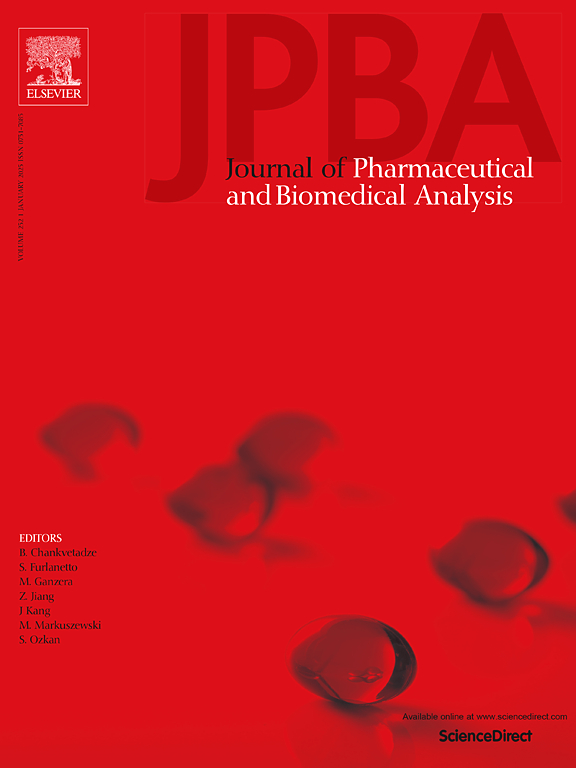用UHPLC-HRMS和NMR综合研究了加红霉素有效成分主要降解杂质的降解途径和形成机制
IF 3.1
3区 医学
Q2 CHEMISTRY, ANALYTICAL
Journal of pharmaceutical and biomedical analysis
Pub Date : 2025-05-14
DOI:10.1016/j.jpba.2025.116969
引用次数: 0
摘要
加霉素是一种半合成抗菌剂,用于治疗牛呼吸道疾病。本研究主要对加红霉素的降解杂质进行了分离鉴定,并对其降解机制进行了阐述。在酸、碱、氧化(使用H2O2和K2Cr2O7)、热、光解等应激条件下,按照VICH/ICH指南对加霉素原料药进行了全面的强制降解分析。色谱柱为Agilent Poroshell HPH-C18(50 mm × 2.1 mm, 1.9 µm),温度为60℃,采用梯度洗脱,采用高效液相色谱分离。流动相为10 mM的NH4HCO3水溶液(a)和乙腈-甲醇(7:3,v/v)的混合物(b)。本研究利用高分辨率质谱联用串联质谱法鉴定了加霉素原料药中的6种降解杂质和5种附加的工艺杂质。对于杂质6,使用核磁共振波谱进行了额外的研究以确定其结构。并提出了降解杂质的形成机理。这些发现增强了对加红霉素稳定性特征的理解,并将为含加红霉素的制剂的配方提供重要见解。本文章由计算机程序翻译,如有差异,请以英文原文为准。
Comprehensive study of degradation pathways and formation mechanism of major degradation impurities of gamithromycin active ingredient by UHPLC-HRMS and NMR
Gamithromycin is a semi-synthetic antibacterial agent used for treating cattle bovine respiratory disease. This study was performed focusing on separating and identifying the degradation impurities of gamithromycin while elucidating its degradation mechanisms. A comprehensive forced degradation analysis was meticulously conducted on the gamithromycin drug substance following VICH/ICH guidelines under a range of stress conditions, including acid, base, oxidation (using H2O2 and K2Cr2O7), thermal, and photolytic stress. The analytes were separated by ultra-high performance liquid chromatography using a gradient elution on an Agilent Poroshell HPH-C18 column (50 mm × 2.1 mm, 1.9 µm) at a temperature of 60 °C. The mobile phases employed were 10 mM aqueous NH4HCO3 as mobile phase-A and a mixture of acetonitrile and methanol (7:3, v/v) as mobile phase-B. This study identified six degradation and five additional process impurities in the gamithromycin drug substance using high-resolution mass spectrometry in conjunction with tandem mass spectrometry. For impurity 6, an additional investigation was performed using nuclear magnetic resonance spectroscopy to confirm its structure. Mechanisms for the formation of the degradation impurities were also proposed. These findings enhance the understanding of the stability characteristics of gamithromycin and would provide significant insights for the formulation of drug products that include this drug.
求助全文
通过发布文献求助,成功后即可免费获取论文全文。
去求助
来源期刊
CiteScore
6.70
自引率
5.90%
发文量
588
审稿时长
37 days
期刊介绍:
This journal is an international medium directed towards the needs of academic, clinical, government and industrial analysis by publishing original research reports and critical reviews on pharmaceutical and biomedical analysis. It covers the interdisciplinary aspects of analysis in the pharmaceutical, biomedical and clinical sciences, including developments in analytical methodology, instrumentation, computation and interpretation. Submissions on novel applications focusing on drug purity and stability studies, pharmacokinetics, therapeutic monitoring, metabolic profiling; drug-related aspects of analytical biochemistry and forensic toxicology; quality assurance in the pharmaceutical industry are also welcome.
Studies from areas of well established and poorly selective methods, such as UV-VIS spectrophotometry (including derivative and multi-wavelength measurements), basic electroanalytical (potentiometric, polarographic and voltammetric) methods, fluorimetry, flow-injection analysis, etc. are accepted for publication in exceptional cases only, if a unique and substantial advantage over presently known systems is demonstrated. The same applies to the assay of simple drug formulations by any kind of methods and the determination of drugs in biological samples based merely on spiked samples. Drug purity/stability studies should contain information on the structure elucidation of the impurities/degradants.

 求助内容:
求助内容: 应助结果提醒方式:
应助结果提醒方式:


